Xinhan Di
Preview WB-DH: Towards Whole Body Digital Human Bench for the Generation of Whole-body Talking Avatar Videos
Aug 12, 2025Abstract:Creating realistic, fully animatable whole-body avatars from a single portrait is challenging due to limitations in capturing subtle expressions, body movements, and dynamic backgrounds. Current evaluation datasets and metrics fall short in addressing these complexities. To bridge this gap, we introduce the Whole-Body Benchmark Dataset (WB-DH), an open-source, multi-modal benchmark designed for evaluating whole-body animatable avatar generation. Key features include: (1) detailed multi-modal annotations for fine-grained guidance, (2) a versatile evaluation framework, and (3) public access to the dataset and tools at https://github.com/deepreasonings/WholeBodyBenchmark.
JWB-DH-V1: Benchmark for Joint Whole-Body Talking Avatar and Speech Generation Version 1
Jul 28, 2025Abstract:Recent advances in diffusion-based video generation have enabled photo-realistic short clips, but current methods still struggle to achieve multi-modal consistency when jointly generating whole-body motion and natural speech. Current approaches lack comprehensive evaluation frameworks that assess both visual and audio quality, and there are insufficient benchmarks for region-specific performance analysis. To address these gaps, we introduce the Joint Whole-Body Talking Avatar and Speech Generation Version I(JWB-DH-V1), comprising a large-scale multi-modal dataset with 10,000 unique identities across 2 million video samples, and an evaluation protocol for assessing joint audio-video generation of whole-body animatable avatars. Our evaluation of SOTA models reveals consistent performance disparities between face/hand-centric and whole-body performance, which incidates essential areas for future research. The dataset and evaluation tools are publicly available at https://github.com/deepreasonings/WholeBodyBenchmark.
Towards Video to Piano Music Generation with Chain-of-Perform Support Benchmarks
May 26, 2025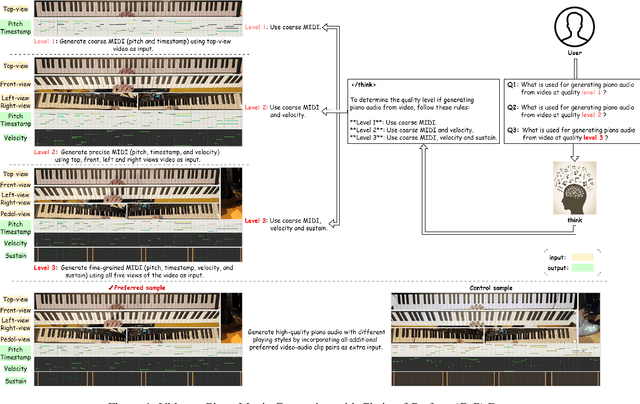
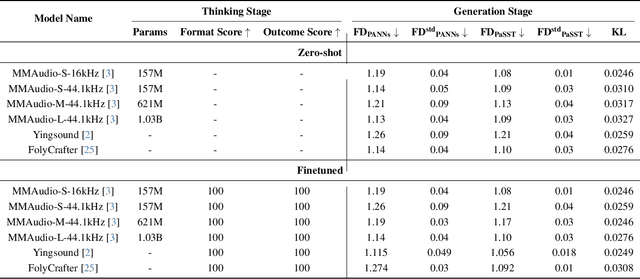
Abstract:Generating high-quality piano audio from video requires precise synchronization between visual cues and musical output, ensuring accurate semantic and temporal alignment.However, existing evaluation datasets do not fully capture the intricate synchronization required for piano music generation. A comprehensive benchmark is essential for two primary reasons: (1) existing metrics fail to reflect the complexity of video-to-piano music interactions, and (2) a dedicated benchmark dataset can provide valuable insights to accelerate progress in high-quality piano music generation. To address these challenges, we introduce the CoP Benchmark Dataset-a fully open-sourced, multimodal benchmark designed specifically for video-guided piano music generation. The proposed Chain-of-Perform (CoP) benchmark offers several compelling features: (1) detailed multimodal annotations, enabling precise semantic and temporal alignment between video content and piano audio via step-by-step Chain-of-Perform guidance; (2) a versatile evaluation framework for rigorous assessment of both general-purpose and specialized video-to-piano generation tasks; and (3) full open-sourcing of the dataset, annotations, and evaluation protocols. The dataset is publicly available at https://github.com/acappemin/Video-to-Audio-and-Piano, with a continuously updated leaderboard to promote ongoing research in this domain.
MM-MovieDubber: Towards Multi-Modal Learning for Multi-Modal Movie Dubbing
May 22, 2025Abstract:Current movie dubbing technology can produce the desired speech using a reference voice and input video, maintaining perfect synchronization with the visuals while effectively conveying the intended emotions. However, crucial aspects of movie dubbing, including adaptation to various dubbing styles, effective handling of dialogue, narration, and monologues, as well as consideration of subtle details such as speaker age and gender, remain insufficiently explored. To tackle these challenges, we introduce a multi-modal generative framework. First, it utilizes a multi-modal large vision-language model (VLM) to analyze visual inputs, enabling the recognition of dubbing types and fine-grained attributes. Second, it produces high-quality dubbing using large speech generation models, guided by multi-modal inputs. Additionally, a movie dubbing dataset with annotations for dubbing types and subtle details is constructed to enhance movie understanding and improve dubbing quality for the proposed multi-modal framework. Experimental results across multiple benchmark datasets show superior performance compared to state-of-the-art (SOTA) methods. In details, the LSE-D, SPK-SIM, EMO-SIM, and MCD exhibit improvements of up to 1.09%, 8.80%, 19.08%, and 18.74%, respectively.
Towards Film-Making Production Dialogue, Narration, Monologue Adaptive Moving Dubbing Benchmarks
Apr 30, 2025Abstract:Movie dubbing has advanced significantly, yet assessing the real-world effectiveness of these models remains challenging. A comprehensive evaluation benchmark is crucial for two key reasons: 1) Existing metrics fail to fully capture the complexities of dialogue, narration, monologue, and actor adaptability in movie dubbing. 2) A practical evaluation system should offer valuable insights to improve movie dubbing quality and advancement in film production. To this end, we introduce Talking Adaptive Dubbing Benchmarks (TA-Dubbing), designed to improve film production by adapting to dialogue, narration, monologue, and actors in movie dubbing. TA-Dubbing offers several key advantages: 1) Comprehensive Dimensions: TA-Dubbing covers a variety of dimensions of movie dubbing, incorporating metric evaluations for both movie understanding and speech generation. 2) Versatile Benchmarking: TA-Dubbing is designed to evaluate state-of-the-art movie dubbing models and advanced multi-modal large language models. 3) Full Open-Sourcing: We fully open-source TA-Dubbing at https://github.com/woka- 0a/DeepDubber- V1 including all video suits, evaluation methods, annotations. We also continuously integrate new movie dubbing models into the TA-Dubbing leaderboard at https://github.com/woka- 0a/DeepDubber-V1 to drive forward the field of movie dubbing.
OCC-MLLM-CoT-Alpha: Towards Multi-stage Occlusion Recognition Based on Large Language Models via 3D-Aware Supervision and Chain-of-Thoughts Guidance
Apr 07, 2025


Abstract:Comprehending occluded objects are not well studied in existing large-scale visual-language multi-modal models. Current state-of-the-art multi-modal large models struggles to provide satisfactory results in understanding occluded objects through universal visual encoders and supervised learning strategies. Therefore, we propose OCC-MLLM-CoT-Alpha, a multi-modal large vision language framework that integrates 3D-aware supervision and Chain-of-Thoughts guidance. Particularly, (1) we build a multi-modal large vision-language model framework which is consisted of a large multi-modal vision-language model and a 3D reconstruction expert model. (2) the corresponding multi-modal Chain-of-Thoughts is learned through a combination of supervised and reinforcement training strategies, allowing the multi-modal vision-language model to enhance the recognition ability with learned multi-modal chain-of-thoughts guidance. (3) A large-scale multi-modal chain-of-thoughts reasoning dataset, consisting of $110k$ samples of occluded objects held in hand, is built. In the evaluation, the proposed methods demonstrate decision score improvement of 15.75%,15.30%,16.98%,14.62%, and 4.42%,3.63%,6.94%,10.70% for two settings of a variety of state-of-the-art models.
DeepDubber-V1: Towards High Quality and Dialogue, Narration, Monologue Adaptive Movie Dubbing Via Multi-Modal Chain-of-Thoughts Reasoning Guidance
Mar 31, 2025Abstract:Current movie dubbing technology can generate the desired voice from a given speech prompt, ensuring good synchronization between speech and visuals while accurately conveying the intended emotions. However, in movie dubbing, key aspects such as adapting to different dubbing styles, handling dialogue, narration, and monologue effectively, and understanding subtle details like the age and gender of speakers, have not been well studied. To address this challenge, we propose a framework of multi-modal large language model. First, it utilizes multimodal Chain-of-Thought (CoT) reasoning methods on visual inputs to understand dubbing styles and fine-grained attributes. Second, it generates high-quality dubbing through large speech generation models, guided by multimodal conditions. Additionally, we have developed a movie dubbing dataset with CoT annotations. The evaluation results demonstrate a performance improvement over state-of-the-art methods across multiple datasets. In particular, for the evaluation metrics, the SPK-SIM and EMO-SIM increases from 82.48% to 89.74%, 66.24% to 78.88% for dubbing setting 2.0 on V2C Animation dataset, LSE-D and MCD-SL decreases from 14.79 to 14.63, 5.24 to 4.74 for dubbing setting 2.0 on Grid dataset, SPK-SIM increases from 64.03 to 83.42 and WER decreases from 52.69% to 23.20% for initial reasoning setting on proposed CoT-Movie-Dubbing dataset in the comparison with the state-of-the art models.
Enhance Generation Quality of Flow Matching V2A Model via Multi-Step CoT-Like Guidance and Combined Preference Optimization
Mar 28, 2025Abstract:Creating high-quality sound effects from videos and text prompts requires precise alignment between visual and audio domains, both semantically and temporally, along with step-by-step guidance for professional audio generation. However, current state-of-the-art video-guided audio generation models often fall short of producing high-quality audio for both general and specialized use cases. To address this challenge, we introduce a multi-stage, multi-modal, end-to-end generative framework with Chain-of-Thought-like (CoT-like) guidance learning, termed Chain-of-Perform (CoP). First, we employ a transformer-based network architecture designed to achieve CoP guidance, enabling the generation of both general and professional audio. Second, we implement a multi-stage training framework that follows step-by-step guidance to ensure the generation of high-quality sound effects. Third, we develop a CoP multi-modal dataset, guided by video, to support step-by-step sound effects generation. Evaluation results highlight the advantages of the proposed multi-stage CoP generative framework compared to the state-of-the-art models on a variety of datasets, with FAD 0.79 to 0.74 (+6.33%), CLIP 16.12 to 17.70 (+9.80%) on VGGSound, SI-SDR 1.98dB to 3.35dB (+69.19%), MOS 2.94 to 3.49(+18.71%) on PianoYT-2h, and SI-SDR 2.22dB to 3.21dB (+44.59%), MOS 3.07 to 3.42 (+11.40%) on Piano-10h.
DeepAudio-V1:Towards Multi-Modal Multi-Stage End-to-End Video to Speech and Audio Generation
Mar 28, 2025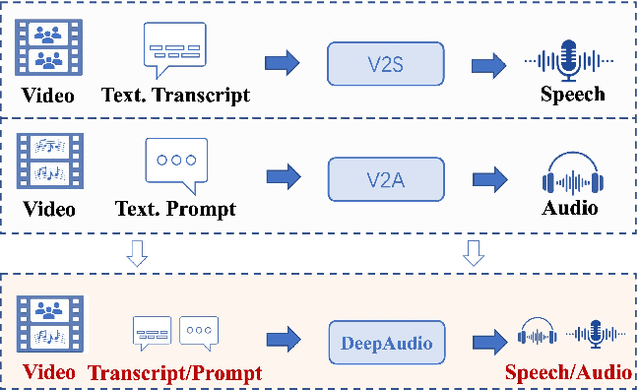
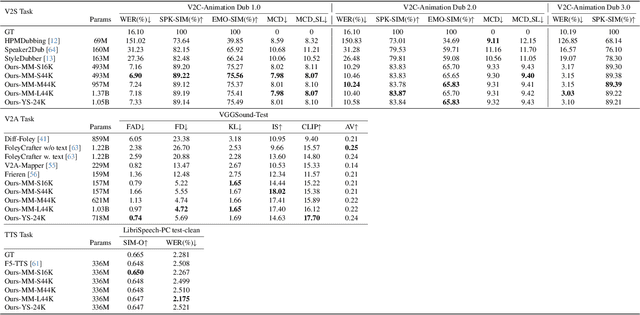
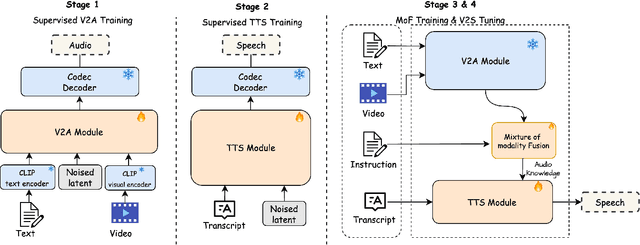

Abstract:Currently, high-quality, synchronized audio is synthesized using various multi-modal joint learning frameworks, leveraging video and optional text inputs. In the video-to-audio benchmarks, video-to-audio quality, semantic alignment, and audio-visual synchronization are effectively achieved. However, in real-world scenarios, speech and audio often coexist in videos simultaneously, and the end-to-end generation of synchronous speech and audio given video and text conditions are not well studied. Therefore, we propose an end-to-end multi-modal generation framework that simultaneously produces speech and audio based on video and text conditions. Furthermore, the advantages of video-to-audio (V2A) models for generating speech from videos remain unclear. The proposed framework, DeepAudio, consists of a video-to-audio (V2A) module, a text-to-speech (TTS) module, and a dynamic mixture of modality fusion (MoF) module. In the evaluation, the proposed end-to-end framework achieves state-of-the-art performance on the video-audio benchmark, video-speech benchmark, and text-speech benchmark. In detail, our framework achieves comparable results in the comparison with state-of-the-art models for the video-audio and text-speech benchmarks, and surpassing state-of-the-art models in the video-speech benchmark, with WER 16.57% to 3.15% (+80.99%), SPK-SIM 78.30% to 89.38% (+14.15%), EMO-SIM 66.24% to 75.56% (+14.07%), MCD 8.59 to 7.98 (+7.10%), MCD SL 11.05 to 9.40 (+14.93%) across a variety of dubbing settings.
DeepSound-V1: Start to Think Step-by-Step in the Audio Generation from Videos
Mar 28, 2025Abstract:Currently, high-quality, synchronized audio is synthesized from video and optional text inputs using various multi-modal joint learning frameworks. However, the precise alignment between the visual and generated audio domains remains far from satisfactory. One key factor is the lack of sufficient temporal and semantic alignment annotations in open-source video-audio and text-audio benchmarks. Therefore, we propose a framework for audio generation from videos, leveraging the internal chain-of-thought (CoT) of a multi-modal large language model (MLLM) to enable step-by-step reasoning without requiring additional annotations. Additionally, a corresponding multi-modal reasoning dataset is constructed to facilitate the learning of initial reasoning in audio generation. In the experiments, we demonstrate the effectiveness of the proposed framework in reducing misalignment (voice-over) in generated audio and achieving competitive performance compared to various state-of-the-art models. The evaluation results show that the proposed method outperforms state-of-the-art approaches across multiple metrics. Specifically, the F DP aSST indicator is reduced by up to 10.07%, the F DP AN N s indicator by up to 11.62%, and the F DV GG indicator by up to 38.61%. Furthermore, the IS indicator improves by up to 4.95%, the IB-score indicator increases by up to 6.39%, and the DeSync indicator is reduced by up to 0.89%.
 Add to Chrome
Add to Chrome Add to Firefox
Add to Firefox Add to Edge
Add to Edge